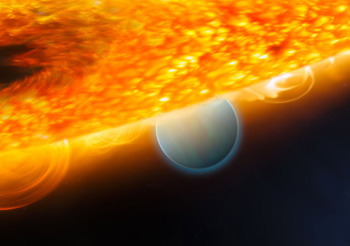HD 10180 is a star that’s nearly the Sun’s twin: it’s very close in mass, temperature, brightness, and even chemical content of our friendly neighborhood star. But in this case of stellar sibling rivalry, HD 10180 may have the upper hand: a new analysis of observations of the star indicate it may have nine planets!
In a new report accepted for publication in the journal Astronomy and Astrophysics, an astronomer re-analyzed data of the star taken with the High Accuracy Radial Velocity Planet Searcher (HARPS), an exquisitely high-precision camera mounted on a 3.6 meter telescope in Chile. HARPS has been observing HD 10180 for years; the star is a mere 130 light years away, making it bright and easy to study. The observations look to see if the star exhibits a periodic shift in its light: a Doppler shift as planets circle it, tugging it one way and another.
Six clear Doppler shift signals were found in the original analysis: six planets, five of which have masses ranging from 12 - 25 times that of the Earth (making them more like Neptune than our own comfortable planet), and a sixth that was bigger yet, 65 times Earth’s mass (more like Saturn than Neptune). These planets orbit HD 10180 with periods of 5 - 2000 days. A seventh possible planet was detected, but the data weren’t strong enough to make a solid claim.
The new analysis looks at the old data in a different way, examining it using different statistical methods. Not only are the six planets seen in the new results, but the seventh is confirmed, as well as finding two additional planets in the data. If this result pans out, that means HD 10180 has nine planets, more than our solar system does!
The three additional planets have masses of 1.3, 1.9, and 5.1 times that of Earth, and orbit the star with periods (think of that as the planets’ years) of 1.2, 10, and 68 days, respectively.
Those first two are pretty firmly in the Earth-mass range, what astronomers call “super Earths”. However, Earth-like they ain’t: they’d be cooked by the star. The first is only 3 million km (less than 2 million miles) from HD 10180, and the second barely any cooler at about 14 million km (8 million miles). This is much closer to the star than Mercury is to the Sun, and remember HD 10180 is very much like the Sun. If those planets are rocky, their surfaces are hot enough to melt tin, zinc, and on that inner planet, maybe even iron.
So yeah, not exactly a fun place to visit.
 An added bonus is that the analysis looked at how stable the orbits are over time. Not all orbits are stable; if two planets occupy certain orbits then they can tug on each other enough over time to make the orbits unstable. It’s like pumping your legs on a swing; do it with the right timing and you can change your swing. In this case, the analysis showed the orbits are stable over time. That doesn’t prove the planets exist, but it does add confidence to the analysis.
An added bonus is that the analysis looked at how stable the orbits are over time. Not all orbits are stable; if two planets occupy certain orbits then they can tug on each other enough over time to make the orbits unstable. It’s like pumping your legs on a swing; do it with the right timing and you can change your swing. In this case, the analysis showed the orbits are stable over time. That doesn’t prove the planets exist, but it does add confidence to the analysis.
And if this does all turn out to be correct, it’s amazing! We’ve been detecting planets around other stars for a while now, including those in multiple systems. But those generally have four planets or fewer; even finding six planets around HD 10180 would be a record. With three more, this would put HD 10180 firmly ahead of every other system detected.
Heck, it beats us. Mind you, no matter where you fall in the Pluto planetary club membership debate, these objects are all more massive even than Earth, so they are most assuredly planets.
Even though this system is very alien to ours, with far more massive planets packed more tightly around their star, most of them cooked to boiling, it’s still a very, very encouraging result. 15 years ago we didn’t know of any other planets orbiting other stars. Now we know of hundreds, with thousands more candidates. And many of these are parts of systems, planetary families a bit like our own. We used to wonder if our solar system was the only one like it in the Universe; unique among the stars.
And now we know the answer: No. And that’s a pretty cool thing to know.
Tip o’ the lens cap to Emily Lakdawalla. Image credit: ESO/L. Calçada; ESA, NASA, M. Kornmesser (ESA/Hubble) and STScI
Related Posts:
- 50 new worlds join the exoplanet list!
- Another Kepler milestone: Astronomers find two Earth-sized planets orbiting the same star!
- Nearby planetary system is seriously screwed up
- A tiny wobble reveals a massive planet